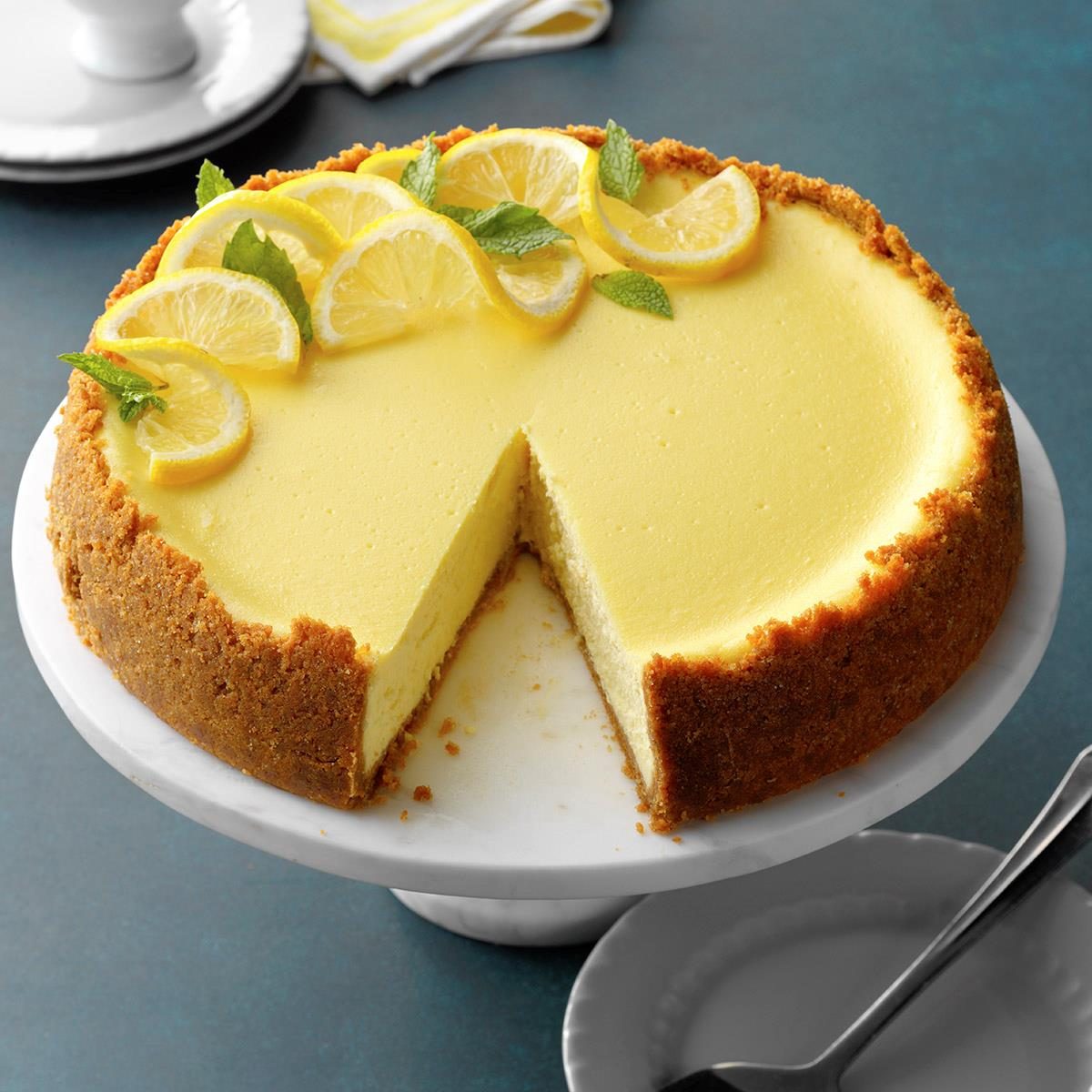Lemon cheesecake is a dessert that has become a favorite for its bright flavor and creamy texture, marrying the zesty tang of lemon with the rich, smooth quality of cheesecake. The origins of cheesecake are believed to date back to ancient Greece, where a form of the dish was served to athletes at the Olympic Games. However, the lemon-flavored variant, as it’s known today, is a much more modern invention.
The basic structure of a lemon cheesecake involves a biscuit or pastry crust, typically made from crushed graham crackers or digestive biscuits, which is then filled with a mixture of cream cheese, sugar, eggs, and lemon. The lemon component can manifest as lemon zest, lemon juice, or both, and it introduces a refreshing counterpoint to the density and sweetness of the cream cheese mixture. Some versions might also include sour cream for added tartness and smoothness.
The cheesecake can be either baked or set in the refrigerator (no-bake), with the baked version having a denser, custard-like texture, while the no-bake version tends to be lighter and more mousse-like. Garnishes can include whipped cream, lemon slices, or a lemon curd topping for an extra burst of lemon flavor. Variants of the recipe may introduce additional flavors or modifications, like incorporating a layer of lemon curd beneath the cheesecake filling or infusing the crust with lemon zest for a more pronounced lemon taste throughout the dessert.
Lemon cheesecake


Lemon cheesecake
Equipment
- 1 blender
Ingredients
Products for Lemon cheesecake
- Blatt
- 300 g of tea vanilla biscuits
- 200 g of roasted unsalted hazelnuts
- 150 g of soft butter
Cream for Lemon cheesecake
- 500 g Rickata cheese
- 200 g of sugar
- 400 g of sour cream
- 15 g of gelatin 1 and 1/2 pack
- juice and bark of 1 lemon
- 50 ml lemon liqueur
- 2 vanilla
Jele for Lemon cheesecake
- 300 g of water
- juice from and lemon peel
- 100 g of sugar
- 1/2 capsule of lemon essence
- 50 ml lemon liqueur
- 10 g of gelatin 1 sachet
- yellow confectionary paint
Instructions
- Cook biscuits, hazelnuts and butter in the kitchen robot. Grind until you get the oil crumbs. Pour them in a tortelized form with a movable board and press against the blade.
- Beat the sugar cheese with a blender. Add the cream, vanilla, lemon juice and lemon as well as the liqueur. Finally, add the gelatine dissolved in water in a little water. Pour the cream over the biscuit pad and leave it in the refrigerator to tighten.
- Boil for a few minutes syrup of water, juice and lemon peel. Add the other ingredients. After cooling, remove the lemon peel and strain through the strainer. Place the syrup in the refrigerator.
- When it starts gently, pour it onto the already tight cream. Leave the pastry for several hours in the refrigerator to gel well.
- Garnish with whipped cream and sliced lemon. Enjoy!
Video
Cooking tips

- Room Temperature Ingredients: Ensure all your ingredients, particularly the cream cheese and eggs, are at room temperature to achieve a smooth filling.
- Quality of Cream Cheese: Choose full-fat, high-quality cream cheese for better flavor and texture.
- Fine Lemon Zest: Use finely grated lemon zest to infuse the cheesecake with lemon flavor without altering the texture. Make sure no white pith is included as it’s bitter.
- Fresh Lemon Juice: Similarly, fresh lemon juice is superior in flavor to bottled varieties.
- Gentle Mixing: Overmixing can incorporate too much air and cause the cheesecake to rise and fall too quickly, leading to cracks. Mix just until each ingredient is combined.
- Cornstarch or Flour: A small amount of cornstarch or flour can be added to the batter to help prevent cracks as it stabilizes the mixture.
- Water Bath: Baking the cheesecake in a water bath (bain-marie) can help cook it gently and evenly, reducing the risk of cracking.
- Don’t Overcook: Cheesecake is done when the edges are set but the center still jiggles slightly. It will continue to set as it cools.
- Cooling Gradually: Let the cheesecake cool slowly in the turned-off oven with the door ajar to prevent sudden temperature changes that can lead to cracking.
- Refrigeration: Chill the cheesecake thoroughly in the refrigerator, ideally overnight, to ensure it sets completely and develops the right texture.
Serving suggestions
- Classic and Simple: Serve the cheesecake chilled, with a generous dollop of whipped cream on top, and a sprinkle of grated lemon zest for an added burst of fresh lemon flavor.
- Fruit Pairing: Top the cheesecake with fresh berries like raspberries, strawberries, or blueberries, which harmonize beautifully with the tartness of the lemon.
- Lemon Curd Excellence: Spread a thin layer of homemade or high-quality store-bought lemon curd over the cheesecake for an extra lemony kick.
- Mint Freshness: Add a few fresh mint leaves as a garnish for a splash of color and a refreshing contrast to the creamy texture.
- Candied Lemon Slices: Decorate the cheesecake with candied lemon slices for a sweet and tangy treat that also makes for a stunning visual presentation.
- Sauce Drizzle: A raspberry coulis or strawberry sauce can be drizzled over the cheesecake for a delightful mix of sweet and citrus flavors.
- Crunchy Contrast: Sprinkle crushed gingersnaps or toasted nuts on top just before serving to introduce an element of crunch against the smooth filling.
- Citrus Variety: Consider topping the cheesecake with a mix of different citrus segments, such as grapefruit or orange, to play with various citrus notes.
- Chocolate Decadence: For chocolate lovers, a drizzle of dark chocolate ganache can complement the zesty lemon flavor incredibly well.
- Powdered Sugar: Just before serving, a light dusting of powdered sugar can give the cheesecake an elegant touch.
Top 5 FAQs about lemon cheesecake

